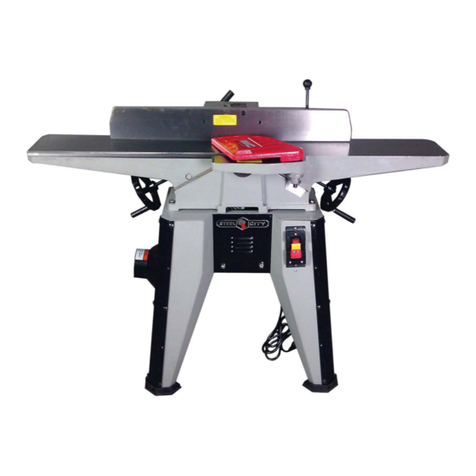
Page 6
4. Prevent electrical shock. Follow all electrical and safety
codes, including the National Electrical Code (NEC) and
the Occupational Safety and Health Regulations
(OSHA). All electrical connections and wiring should be
made by qualified personnel only.
5. A WAYS be sure that the power switch is in the “OFF”
position and unplug the machine from the electrical
receptacle when making adjustments, changing parts or
performing any maintenance.
6. AVOID ACCIDENTA STARTING. Make sure that the
power switch is in the “OFF” position before plugging in
the power cord to the electrical receptacle.
7. NEVER leave a machine running, unattended. Turn the
power switch to the OFF position. DO NOT leave the
machine until it has come to a complete stop.
8. THE USE of extension cords is not recommended for
230V equipment. It is better to arrange the placement
of your equipment and the installed wiring to eliminate
the need for an extension cord. If an extension cord is
necessary, refer to the chart in the Grounding
Instructions section to determine the minimum gauge
for the extension cord. The extension cord must also
contain a ground wire and plug pin.
9. DO NOT pull a machine by the power cord. NEVER
allow the power cord to come in contact with sharp
edges, hot surfaces, oil or grease.
10. DO NOT unplug a machine by pulling on the power
cord. A WAYS grasp the plug, not the cord.
11. REP ACE a damaged cord immediately. DO NOT use
a damaged cord or plug. If the machine is not
operating properly, or has been damaged, left
outdoors or has been in contact with water.
12. NEVER remove any chips without turning off the
machine and disconnecting the power.
13. NEVER turn on the machine if the workpiece is in
contact with the cutterhead.
14. ENSURE that the machine sits firmly on the floor before
using. If the machine wobbles or is unstable, correct the
problem by using shims or blocks prior to operation.
WARNING
!
TO REDUCE the risk of electrical shock. DO NOT use
this machine outdoors. DO NOT expose to rain or
moisture. Store indoors in a dry area. DO NOT handle the
plug with wet hands.
15. A WAYS keep hands and fingers away from the blades
when operating.
16. DO NOT FORCE the machine to perform an
operation for which it was not designed. It will do a safer
and higher quality job by only performing operations for
which the machine was intended.
17. Every work area is different. Always consider safety first,
as it applies to your work area. Use this machine with
respect and caution. Failure to do so could result in
serious personal injury and damage to the machine.
18. DO NOT stand on a machine. Serious injury could
result if it tips over or you accidentally contact any
moving part.
19. DO NOT store anything above or near the machine.
20. REMOVE A MAINTENANCE TOO S from the
immediate area prior to turning the machine ON.
21. MAINTAIN your balance. DO NOT extend yourself over
the tool. Wear oil resistant rubber soled shoes. Keep
floor clear of debris, grease, and wax.
22. DO NOT operate any machine or tool if under the
influence of drugs, alcohol, or medication.
23. MAINTAIN all machines with care. A WAYS KEEP
machine clean and in good working order. KEEP all
blades and tool bits sharp.
24. EACH AND EVERY time, check for damaged parts prior
to using any machine. Carefully check all guards to see
that they operate properly, are not damaged, and
perform their intended functions. Check for alignment,
binding or breakage of all moving parts. Any guard or
other part that is damaged should be immediately
repaired or replaced. KEEP cutterhead knives sharp
and free of all rust and pitch.
25. Safety decals are on this machine to warn and direct
you to how to protect yourself or visitors from personal
injury. These decals MUST be maintained so that they
are legible. REP ACE decals that are not legible.




































